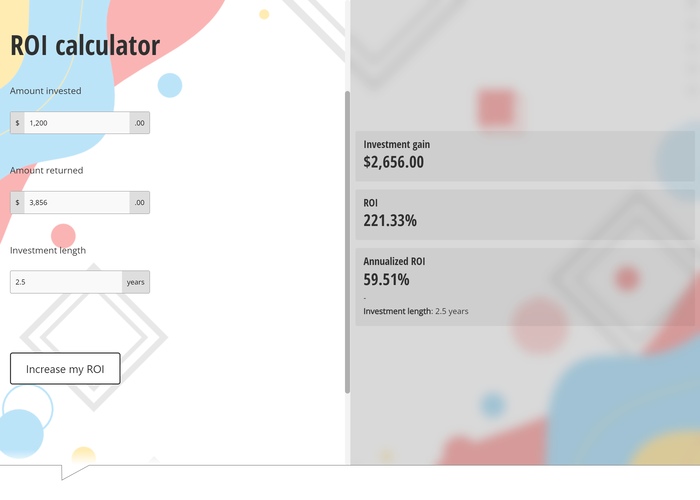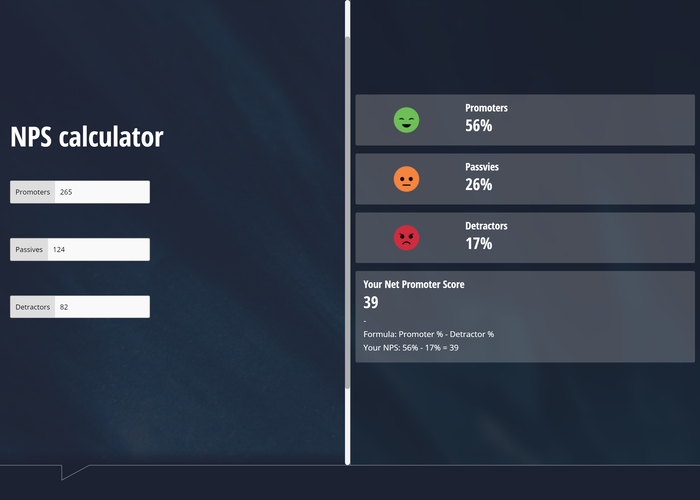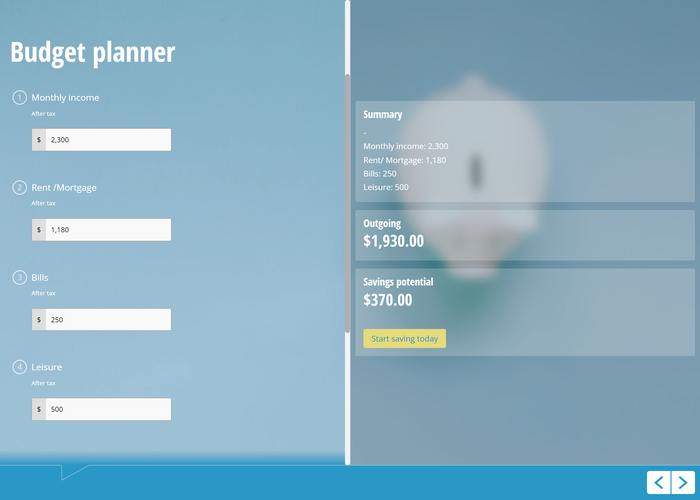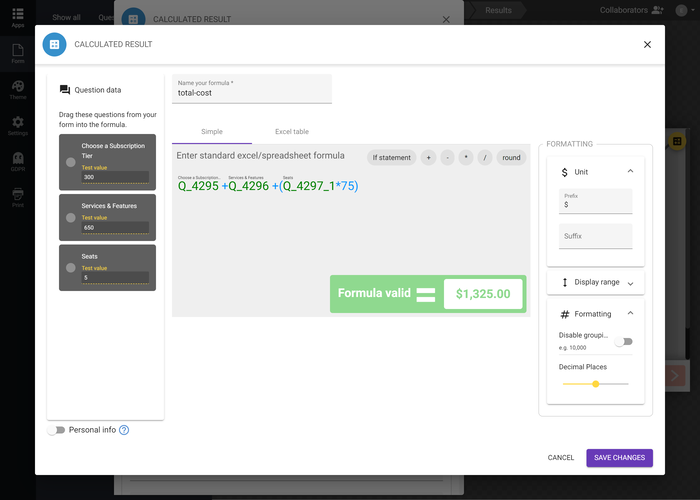Building calculators for websites is a game-changer for businesses seeking to boost traffic, increase user engagement, and generate valuable leads.
What are calculators for websites?
Calculators for websites are interactive tools embedded on a page that allows users to obtain information relevant to their needs, interests, or goals.
These calculators can take various forms and cater to a wide range of industries and niches, serving both curiosity and practical purposes.
A practical example would be building a price quote calculator to improve user experiences.
Benefits of building calculators for websites
In this ever-evolving landscape, static websites with basic content are rapidly losing ground to more dynamic, interactive platforms.
Custom calculators are one such interactive element that can revolutionize your website’s performance in several ways:
- Enhance user experience: Website calculators transform passive visitors into active participants, even allowing them to solve real-life problems.
- Increase traffic: When combined with effective SEO, free online tools (such as calculators) become a magnet for organic traffic.
- Extend user sessions: Engaging content keeps visitors on your site longer, which signals to search engines that your content is valuable.
- Lead generation: When creating calculators for your website, you can target them at specific audiences you want to attract.
- Data collection: Collect anonymous information about a specific niche or even make calculator results gated, exchanging contact information for results.
5 examples of calculators for websites
Let’s get into some of the most popular interactive calculators for websites that you can start using as lead magnets, today.
Don’t worry, we’ll include the relevant formulas along with the example.
1. Mortgage calculator
This is a great option for real estate websites and financial businesses. A mortgage calculator is akin to a Swiss Army knife, serving both potential home buyers and the business itself.

Not only can you provide instant personalized information to visitors, you also collect real-time data on trends and preferences.
Mortgage calculator formula
The formula for a fixed rate loan would be:
Monthly payments = P x (r / n) x (1 + r / n)^n(t)] / (1 + r / n)^n(t) – 1
Monthly repayment formula
Let’s break this down below:
- P: loan amount
- r: interest rate
- t: number of years (loan term)
- n: payments per year
Keep in mind that there are variations of this formula for different types of mortgages. Such as adjustable-rate mortgages (ARMs), where the interest rate can change over time.
2. ROI calculator
An ROI (Return on Investment) calculator is a versatile tool that holds immense value for businesses across various industries.

By allowing users to input investment figures, returns, and time frames, these website calculators can instantly calculate the potential ROI. This empowers prospects to make informed decisions about whether your product or service aligns with their financial goals.
ROI calculator formula
The below ROI calculation will return a percentage:
ROI = (Investment return – Amount invested) / Amount invested * 100
Return on investment formula
If you also wanted to calculate annualized ROI, where the length of investment is also include, use the below formula:
Annualized ROI = ((1+ ((Investment return – Amount invested) / Amount invested) -1) * 100
Annualized ROI formula
3. BMI calculator
In the health industry, information is empowerment, and a BMI (Body Mass Index) calculator is a fantastic example of this.

The keyword “BMI calculator” receives over 1.8 million searches per month. This gives you a huge opportunity to reach a massive audience.
A BMI calculator offers users a straightforward and quick method to assess their body composition. It operates on a simple formula that takes into account a person’s weight in kilograms and their height in meters:
BMI calculator formula
The below formula will return your visitors Body Mass Index.
BMI = Weight in kg / (height in meters)²
BMI formula
Users seeking to improve their health and fitness are likely to return to your site for guidance and support. This positions you as a trustworthy source of information.
4. NPS calculator
NPS (Net Promoter Score) helps businesses gauge customer loyalty and sentiment in regards to their business, brand or products.

Lots of businesses, especially small businesses, may collect feedback from customers but not have the budget to afford software to quantify this for them.
Creating a free NPS calculator would provide value to those wanting to calculate their Net Promoter Score without breaking the bank.
NPS calculator formula
Here’s the formula for calculating Net Promoter Score:
NPS = Percentage of Promoters – Percentage of Detractors
NPS formula
5. Budget planner calculator
Creating a budget planner calculator for a website allows you to provide a practical tool that’s relevant a wide range of visitors.

It can be useful for businesses to set project budgets and individuals seeking control over personal finances.
Budget planner calculator formula
You can find the formula for creating a budget planner calculator below:
Savings = Salary – Expenses
Budget planner formula
It’s up to you to define what contributes to monthly expenses. This can include:
- Rent / mortage
- Food & shopping
- Bills
- Tax
- Leisure spend
Users seeking financial guidance are likely to engage with your calculator. This provides a gateway for you to offer personalized consultation, educational content, and financial services.
How to create custom calculators for websites
Before you get started creating calculators for websites, you ‘ll want to ensure that the software you choose has the following capabilities.
- Simple and table-based formula builders
- Advanced operators and functions
- Mobile-friendly designs
- Results analysis tools
- Embeddable calculators & other distribution options.
Now, let’s dive into the steps you need to take for creating calculators for websites. For this walk through, we’ll provide both general advice and specifics for using Shout’s calculator builder.
Step 1. Choose a calculator style
Simpy put, this boils down to whether you want to display all calculator questions on a single page or display these fields one at a time.
Both have their benefits, but it depends on your personal style and what you’re trying to achieve.
Shout allows you to show multiple or single questions per page, but with either navigation style you can add more sections and pages. There’s no limit to your set up, and you can even combine this with question logic to create personalized paths.
Step 2. Add calculator questions
To increase engagement levels, we recommend using a varied range of calculator question types.
With Shout, you can use over 20 questions types in your calculators. These include everything from numeric questions like Age and Currency to closed questions like Multiple-Choice and Sliders.
Step 3. Build a formula
The next step is to start building a formula for your calculator. You can reference the one’s we’ve used above or use a search engine to find the exact formula you need.

With Shout, you have two options for build a formula. Firstly, you have access to our simple formula builder, which allows you to drag and drop in your questions and use basic and advanced operators.
You can also use our Excel-style table, where you can import your own datasets and reference that data in your formulae.
With both formula builders, you can employ advanced operators such as IF statements, logarithmic and root calculations. In fact, you can use almost any operator available in Excel or Sheets.
Step 4. Choose how to display your results
You have two options when it comes to displaying results; show them side-by-side with your calculator or make your results gated. Which you choose depends on your goal.
Increase traffic
If your goal to boost traffic, we recommend showing results to visitors in real time. This ensures there’s no friction for visitors and increases the likelihood of repeat visits in the future.
With Shout, you can fully customize what results to show side-by-side with your calculator. Personalize these with question answers, CRM data, images, calls-to-action, and any formulas you’ve created.
Generate leads
If your goal is to generate leads and collect contact information, you’ll likely want to gate your results. Naturally, the calculator results will act as an incentive for visitors to submit exchange their contact details.
With Shout, you’d simply need to add a contact form between your calculator and the Results page. Visitors won’t be able to view their results until they enter their contact info.
Step 5. Embed the calculator on your website
Once you’ve finalized your formula and design, it’s time to embed the calculator on your website. If this is a particularly common calculator, you have to ensure to add SEO content to the landing page.
Embedding a web calculator with Shout is easy, we provide a line of code and you paste it into your website.
If you’re using a content management system, such as WordPress, you can paste this code into a HTML element.
Wrapping up: calculators for websites
In a competitive online landscape, businesses must continually seek innovative ways to stand out and connect with their target audience.
Online calculators for websites offer precisely that—a dynamic, user-centric approach to engagement that enriches the UX and generates leads for business growth.



